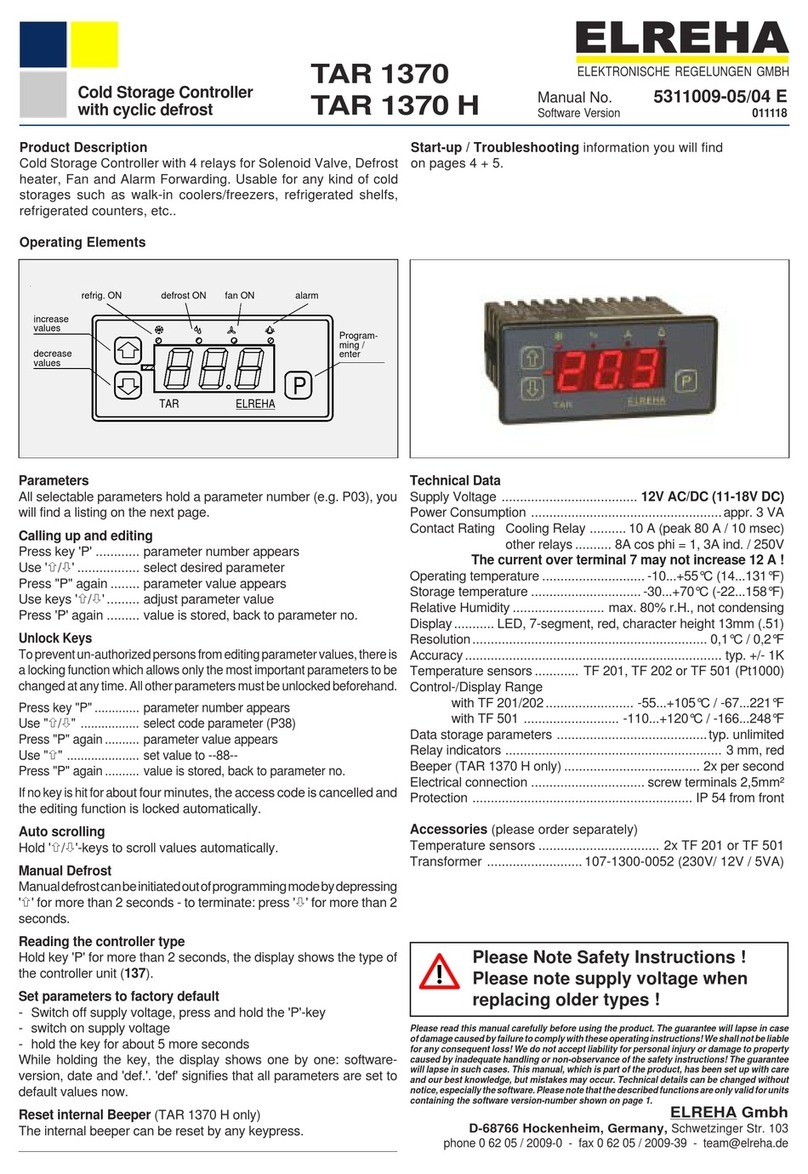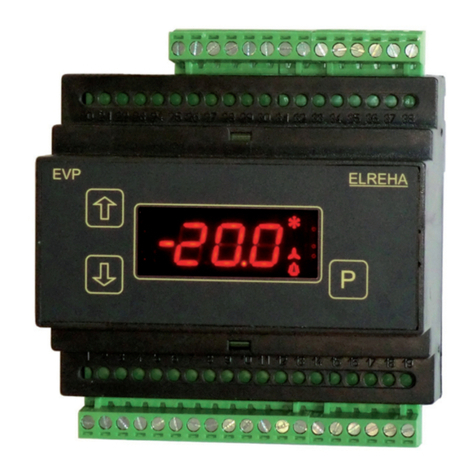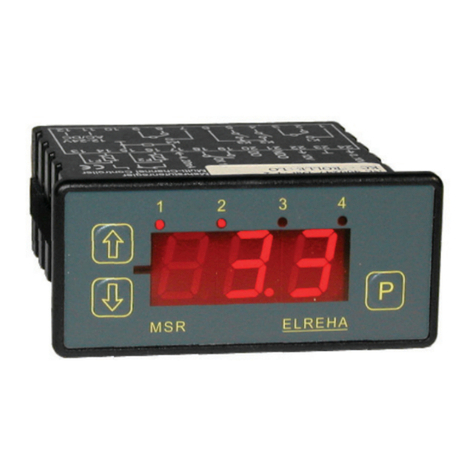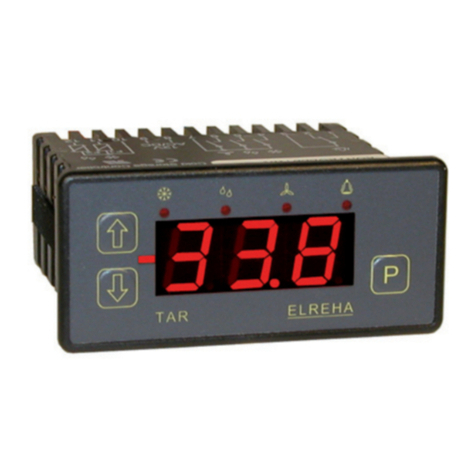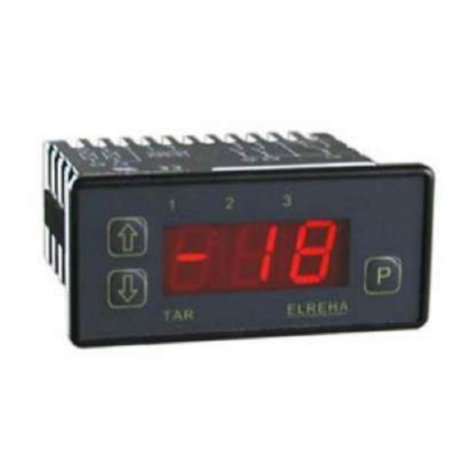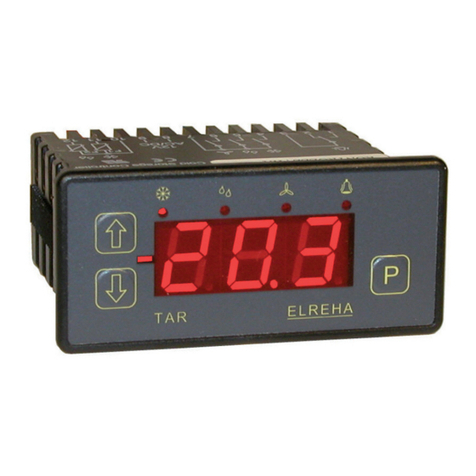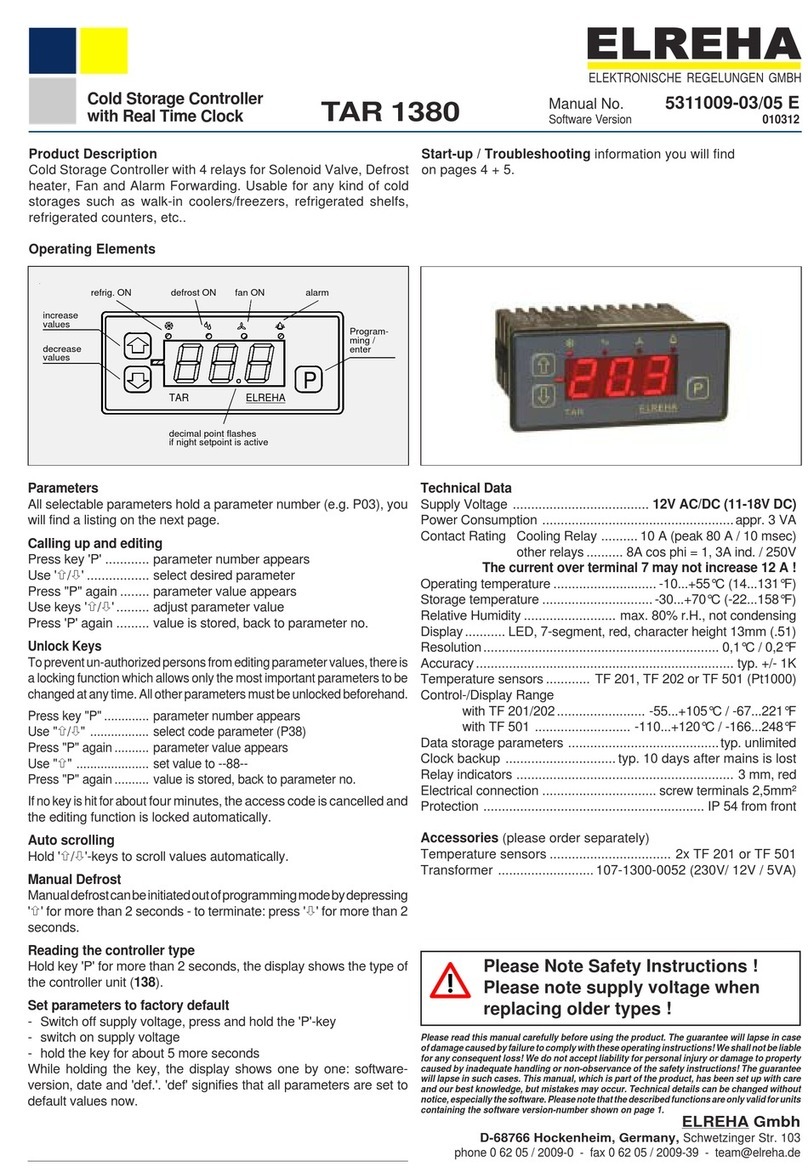Page 2 Technical Manual Temperature-, Humidity-, Pressure-Controller TAR x260
Technical Data
Operating Voltage .............. see type overview
Power Consumption ........... approx. 3,5 VA
Output relays....................... 3x potential free
Relay rating ........................ 8A cos phi=1, 3A ind. / 250V AC
Operating Temp. ................ -10...+55°C / 14...131°F
Storage Temp..................... -30...+70°C / -22...158°F
Air humidity......................... max. 85% r.H., not condensing
Signal inputs ....................... 2x TF201(PTC) orTF501 (Pt1000),
1x 4...20 mA, 100 ohms shunt
Transmitter supply.............. appr. 12VDC unreg., max. 35 mA
Display ................................ LED, character height 13mm
19"-module : char. height 10mm
Resolution........................... 0,1 / °C, 0,2 / °F
Control-/Display range ....... -100...+300 (°C, bar, °F up to +572)
Data storage parameters ... typ. 10 years
Relay indicator.................... LED 2 mm, red
Digital Input (Optocpl.) ....... 230V, 3mA (1260: external switch)
Analogue output .................. 0-10 V DC, max. 3 mA
Resolution Analogue Outp. . 8 bit within the set limit values
Data interface ..................... RS-485 (
E-Link
)
Electrical connection .......... Screw terminals 2,5mm
19"-module : connector "F"
Housing, Protection
TAR 1260 ................ 77 x 35 mm, IP 54 from front
TAR (2)3260 ............ for 35mm DIN-rail, IP 30
TAR (2)5260 ............ 96 x 48 mm, IP 54 from front
TAR (2)19260 .......... 19"module, 8 TE
Further information you will find in the parameter listing
Type Overview
TAR 1260 ........... Panel mounting, 12-24V AC/DC
TAR 3260 ........... for 35mm DIN-rail, 230V~, 50-60 Hz
TAR 5260 ........... Panel mounting, 230V~, 50-60 Hz
TAR 19260 ......... 19"-Module, 8TE, 230V~, 50-60 Hz
TAR 23260 ......... for 35mm DIN-rail, 115V~, 60 Hz
TAR 25260 ......... Panel mounting, 115V~, 60 Hz
TAR 29260 ......... 19"-Module, 8TE, 115V~, 60 Hz
Accessories (please order separately)
- TemperaturesensorTF201(max.80°C)
or
PT1000(max.300°C)
- Two-wire pressure transmitter, Type DG... or similar with
4-20 mA signal output
- Humidity transmitter FF 2520 with 4...20mA output
- For type TAR 1260: Matching transformer, please contact us.
- For type TAR 19260: Subrack or Panel housing
Contents
page
Safety Instructions ..........................................................2
Operating / Operating Elements / Failure Displays..........3
Access protection..............................................................3
Parameter listing ...............................................................4-5
Functional Description
Value sources, Operating modes
Alarm, Switching modes, Digital Input, Analogue output
Networking.........................................................................9
Dimensions/ Wiring ...........................................................11
Run-Up Examples .............................................................15
Please read before Start-up
• Limit of Application: This product is not designed nor
manufactured for use in equipment or systems that are
intended to be used under such circumstances that may
affect human life.
Forapplicationsrequiringextremelyhighreliability,please
contact the manufacturer first
• Electrical installation and putting into service must be
done from authorized personnel.
• Please note the local safety instructions !
• Before installation: Check the limits of the controller and
yourapplication.Beforestartingupwerecommendyouto
readthefollowinginstructionsfor use, since onlybydoing
so you can avoid damage or malfunction and you will
benefit all the advantages offered by this product.
•During installation and wiring never work when the
electricity is not cut-off !
• If the units should be networked, never connect the
secondary coil of 12/24V transformers to PE !
• To control servo drives/actuators, a TAR 1260 must be
supplied by a separate transformer
• Mounting the controller close to power relays is
unfavourableincaseoftheelectro-magneticinterference.
• Before applying voltage to the controller:
Make sure that all wiring has been made in accordance
with the wiring diagram in this manual.
Check, if the supply voltage corresponds to the value
printed on the type label.
• Connect the ‘PE’ terminal carefully to ground because
otherwise the operation of the internal noise filter will be
disabled.
• Respect the environmental limits for temperature and
humidity. Outside these limits malfunctions may occur.
•Never operate unit without housing.
• Observe the maximum admitted current rate for the
relays (see technical data). Compare with the peak start-
up current of the controlled devices (valve, fan,
compressor, heater..)
• Sensor cables may be up to some hundred meters in
length. Use shielded sensor cable only. Don’t install them
in parallel with high-current cables to prevent inductive
interference. A cross section of min. 0,5mm² is sufficient.
• Shielding has to be connected to PE at the end near the
controller
• All used temperature sensors must be identical. Never
use PTC (TF 201) and PT1000 (TF 501) mixed. This will
not work.
• TF-type sensors are moisture-proof but they are not
designed for being immersed in water for a long period of
time(not pressure-proof).Insuch acase,always usedip-
fittings.
• Be care that the wiring of interface lines meets the
requirements
CONNECTION & SAFETY INFORMATIONS
